
The Areas of Outstanding Natural Beauty in Wales are areas of countryside that have been designated for statutory protection due to their significant landscape value in Wales. There are currently five areas designated, four wholly in Wales and another spanning the Wales-England border, accounting for 4% of Wales' land area. The responsibility of designating areas in recognition of their national importance is devolved to Wales and performed by Natural Resources Wales, on behalf of the Welsh Government. The designation is also used in England, and Northern Ireland. Areas of Outstanding Natural Beauty enjoy levels of protection from development similar to those of Welsh national parks, but unlike national parks, the responsible AONB bodies do not have their own planning powers, instead are performed by local authorities. They also differ from national parks in their more limited opportunities for extensive outdoor recreation. It has been proposed that the designation be renamed to National Landscapes of Wales, however, such proposals have failed to be followed through.

The Wildlife and Countryside Act 1981 is an Act of Parliament in the United Kingdom implemented to comply with European Council Directive 79/409/EEC on the conservation of wild birds. In short, the act gives protection to native species, controls the release of non-native species, enhances the protection of Sites of Special Scientific Interest and builds upon the rights of way rules in the National Parks and Access to the Countryside Act 1949. The Act is split into 4 parts covering 74 sections; it also includes 17 schedules.
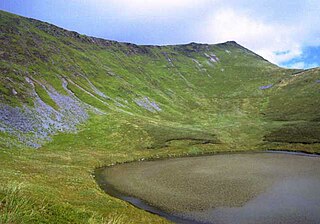
The Berwyn range is an isolated and sparsely populated area of moorland in the northeast of Wales, roughly bounded by Llangollen in the northeast, Corwen in the northwest, Bala in the southwest, and Oswestry in the southeast.

The Clocaenog Forest is in west Denbighshire and east Conwy, Wales on Mynydd Hiraethog. It takes its name from the village of Clocaenog, near Ruthin.

The Cotswold Water Park is the United Kingdom's largest marl lake system, straddling the Wiltshire–Gloucestershire border, northwest of Cricklade and south of Cirencester. There are 180 lakes, spread over 42 square miles (110 km2).
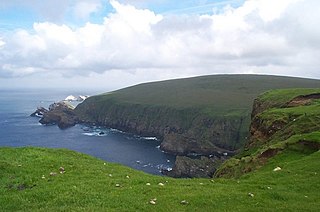
Hermaness is the northernmost headland of Unst, the most northerly inhabited island of Shetland, Scotland. It consists of huge sea cliffs and moorland, making it an ideal habitat for a variety of birds. Hermaness was designated a national nature reserve (NNR) in 1955. The NNR extends over 965 hectares, including the whole of the Hermaness peninsula and the outlying Muckle Flugga and Out Stack. The reserve has a path and boardwalk that extends out onto the moorland. The reserve is managed by NatureScot, though it remains in private ownership, with most being owned by the Buness Estate, although the stacks and skerries around Muckle Flugga are owned by the Northern Lighthouse Board.

RSPB Dearne Valley Old Moor is an 89-hectare (220-acre) wetlands nature reserve in the Dearne Valley near Barnsley, South Yorkshire, run by the Royal Society for the Protection of Birds (RSPB). It lies on the junction of the A633 and A6195 roads and is bordered by the Trans Pennine Trail long-distance path. Following the end of coal mining locally, the Dearne Valley had become a derelict post-industrial area, and the removal of soil to cover an adjacent polluted site enabled the creation of the wetlands at Old Moor.

Llyn Brenig is a reservoir located on Denbigh Moors in North Wales. The artificial lake, which was constructed between 1973 and 1976, was created by building an embankment dam across the Afon Brenig valley. It lies at 1,200 ft (370 m) above sea level on the border between the counties of Conwy and Denbighshire. It is used to manage the flow in the River Dee as part of the River Dee regulation system.
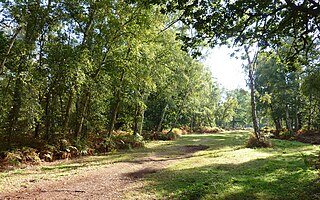
The Great Fen is a habitat restoration project being undertaken on The Fens in the county of Cambridgeshire in the United Kingdom. It is one of the largest restoration projects in the country, and aims to create a 3,700 hectare wetland and aims to connect Woodwalton Fen National Nature Reserve (NNR), Holme Fen NNR and other nature reserves to create a larger site with conservation benefits for wildlife and socio-economic benefits for people.
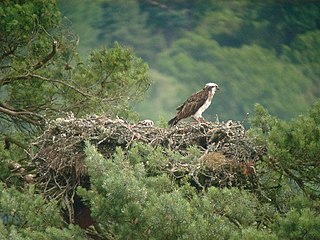
The osprey is a medium large raptor which is a specialist fish-eater with a worldwide distribution. The subspecies Pandion haliaetus haliaetus is native to Eurasia and is found in the British Isles, where it is a scarce breeder primarily in Scotland with smaller numbers in England and Wales. It became extinct in the British Isles in 1916, but recolonised in 1954. Scandinavian birds migrate through Britain on the way to their breeding sites.

The Ruabon Moors are an area of upland moorland in Wales to the west of Ruabon and Wrexham. They lie partly within Wrexham County Borough and partly within Denbighshire.
Llandegla Forest is a forest of planted conifers covering 2.5 sq miles (6.5 km2) in Denbighshire, north-east Wales. It is situated to the south-east of the village of Llandegla at the north-western edge of Ruabon Moors. Only 20 miles from the city of Chester and 7 miles west of Wrexham, easily accessed via the A525 towards Ruthin.

Denbigh Moors is an upland region in Conwy and Denbighshire in north-east Wales, between Snowdonia and the Clwydian Range. It includes the large reservoirs Llyn Brenig and Llyn Alwen, and the Clocaenog Forest, which has one of Wales's last populations of red squirrels. It also contains the open heath Hafod Elwy Moor National Nature Reserve.
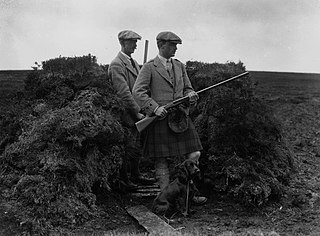
Driven grouse shooting is the hunting of the red grouse, a field sport of the United Kingdom. The grouse-shooting season extends from 12 August, often called the "Glorious Twelfth", to 10 December each year. Large numbers of grouse are driven to fly over people with shotguns. Driven grouse shooting first appeared around 1850 and became popular in the later Victorian era as a fashionable sport for the wealthy. The expanding rail network allowed relatively easy access into the remote upland areas of Britain for the first time and driven grouse shooting developed in tandem with this by providing shooting in a convenient and reliable form. Large numbers of birds are driven over a fixed position providing a regular supply of fast moving targets without the need to seek out the birds. The development of the breech-loading shotgun was also an essential ingredient in the development of the practice as it allowed more rapid reloading in the field matching the availability of target birds.
Stryt Las a'r Hafod is a Site of Special Scientific Interest in the preserved county of Clwyd, north Wales, and specifically in Wrexham County Borough. It includes the parks of Bonc yr Hafod and Stryt Las Park.
Wales is a country that is part of the United Kingdom. Many parts of Wales are protected areas, according to a number of designations. They include the "Designated Landscapes of Wales", consisting of the three national parks and five Areas of Outstanding Natural Beauty.

Cabbage Tree Island, also known as the John Gould Nature Reserve, is a protected nature reserve and uninhabited continental island lying 1.4 km (0.87 mi) off the mouth of Port Stephens on the coast of New South Wales, Australia. The 30 ha (74-acre) reserve and island is named for the Cabbage-tree Palms in the two gullies on the island's western side which are the nesting site of Goulds petrel. It is the principal breeding site of the nominate subspecies of the threatened Gould's petrel and, with the nearby Boondelbah Island where there is also a small colony, has been classified by BirdLife International as an Important Bird Area.

The biodiversity of Wales refers to the wide variety of ecosystems, living organisms, and the genetic makeups found in Wales.

Stryt Las Park is a park situated between Johnstown and Rhosllanerchrugog, in Wrexham County Borough, Wales. It is named after Stryt Las, the street which borders the park to its south. The park is situated on a former colliery and landfill site.
















